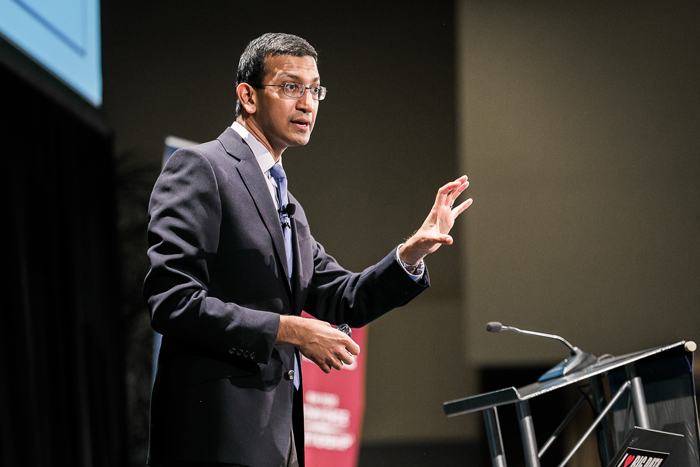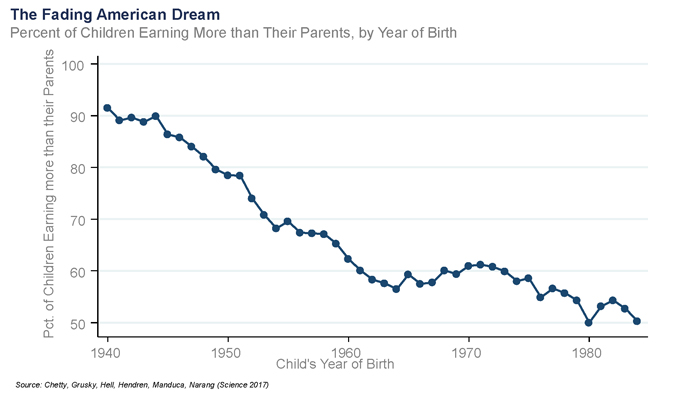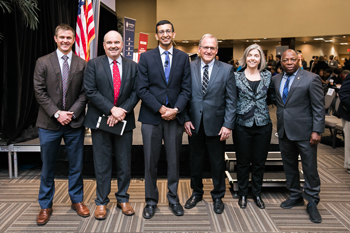 One objective of workforce development is to help people move up the economic ladder, otherwise known as income mobility. The nation’s foremost expert on this topic, renowned Stanford University economics professor Raj Chetty, Ph.D., came to San Diego on February 27 and spoke in front of 300 attendees at the Jacobs Center. The event was co-convened by National University and the San Diego Workforce Partnership.
One objective of workforce development is to help people move up the economic ladder, otherwise known as income mobility. The nation’s foremost expert on this topic, renowned Stanford University economics professor Raj Chetty, Ph.D., came to San Diego on February 27 and spoke in front of 300 attendees at the Jacobs Center. The event was co-convened by National University and the San Diego Workforce Partnership.
A popular TEDx speaker and “Freakonomics Radio” podcast guest, Dr. Chetty earned his Ph.D. from Harvard University in 2003 at the age of 23. He received a MacArthur “Genius” Fellowship and the John Bates Clark medal (awarded to American economists under age 40) and was named one of the most influential economists in the world by The New York Times and The Economist.
At the event, Dr. Chetty shared current research on opportunity and equity based on his ground-breaking analyses of datasets that include childhood through adulthood information about Americans’ education and employment. His research reveals steadily declining income mobility in the U.S. through the second half of the 20th century, as seen in Dr. Chetty’s now-famous chart, below, which was also included in his San Diego lecture. The chart shows that the likelihood that American adults live in a household with higher income than their household as a child has dropped from over 90% for children born in 1940 to just about 50/50 odds for children born in the 80s.

Chetty and his colleagues attribute the decline in income mobility partly to lower rates of economic growth, but they find that greater inequality in the distribution of growth explains most of the large change.
The audience learned from Dr. Chetty that San Diego’s income mobility for children born here in the 1980s was somewhat higher than the national average, but he cautioned that the dramatic rise in our region’s cost of living alongside sluggish wage growth over the ensuing decades has likely eroded the chance of out-earning one’s parents in inflation-adjusted terms.
Dr. Chetty also showed that income mobility varies widely from state to state, region to region and even ZIP code to ZIP code, “Most of the variation in upward mobility is caused by differences in childhood environment,” said Dr. Chetty, referring to geographic location.
In other words, where someone lived as a child impacts earnings as an adult.
The characteristics of high upward mobility areas include less residential racial segregation, a larger middle class, more stable family structure, greater social capital (networks) and higher quality education. Dr. Chetty then uses “big data” to provide targeted diagnoses and recommendations.
Focusing on access to education, Dr. Chetty showed how colleges stack up when it comes to driving income mobility, as measured by the proportion of students who come from the bottom income quintile to end up in the top income quintile. The University of California, San Diego, ranked highest in the San Diego metro region with 4.8 percent of its students rising from the lowest to highest quintile. San Diego State University followed at 3.7 percent and San Diego Community College District was third at 2.7 percent. The rest of the region’s colleges and community colleges posted mobility scores near the national average of 2 percent, while some colleges elsewhere, such as California State University, Los Angeles, scored up to four times higher on this scale.
One of the additional challenges facing our region is rising rates of segregation. “Growing segregation and inequality may limit opportunities for upward mobility in San Diego going forward,” warned Dr. Chetty.
However, we can use fine-grained neighborhood-level data—to be released in May—to design targeted interventions to improve the “opportunity pipeline.”
One potential area for intervention cited by Dr. Chetty was exposing children and teens to inventors and entrepreneurs. Using data regarding patents awarded, Dr. Chetty found high correlation with household income and having an inventor parent, but he believes that mentoring, internships and career education could help all children find their inner Einstein. Dr. Chetty concluded that “If women, minorities, and children from low-income families invent at the same rate as high-income white men, the innovation rate in America would quadruple.” In other words, improving opportunities for upward mobility not only gives more people access to the economic pie, it can also increase size of the pie.
 SDWP is actively using this research to inform its strategic plan, having recently created the Center for Local Income Mobility (CLIMB) to generate opportunities to invest in families and children in San Diego County—the very front end of our workforce pipeline.
SDWP is actively using this research to inform its strategic plan, having recently created the Center for Local Income Mobility (CLIMB) to generate opportunities to invest in families and children in San Diego County—the very front end of our workforce pipeline.
In particular, we are taking a two-generation approach to workforce development—simultaneous investments in the education and skill attainment of parents and their children. When we do this, we have the potential to realize a triple workforce bottom line: Skills of the parent(s), workforce participation and stability of the parent(s) because their children are in quality childcare, and improved workforce trajectory for the child(ren).
“Dr. Chetty’s research tells us that local action by organizations like ours matter for income mobility and opportunity. We are already shifting our program delivery in response to his findings about early opportunities and exposure to innovation,” said Laura Kohn, SDWP’s CLIMB director. “San Diego has the opportunity to pioneer the use of data science to move toward precision workforce development—providing the most effective supports to communities of the highest concerns at the right time.”
The San Diego Workforce Partnership gratefully acknowledges the support of the Hapke Family Fund for this event. In addition to National University as a presenting partner, the event was produced in collaboration with the San Diego Economic Development Corporation, the San Diego Supercomputer Center and the National Laboratory for Education Transformation.
